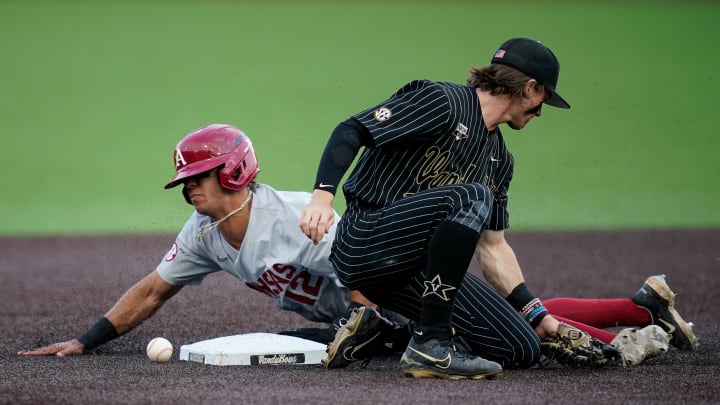How Does The NCAA Baseball Tournament, College World Series Work?

The college baseball postseason is one of the most electric tournaments in sports. However, with over 300 D-I teams to keep track of and what might seem like a nonsensical tournament structure, college baseball itself has a high barrier of entry. Let's take a look at how the tournament works, from campuses to Omaha and, hopefully, lower that barrier of entry.
All aboard the college baseball hype train!
How Do Teams Make The College World Series?
This postseason is made up of three rounds: Regionals, Super Regionals, and the College World Series (CWS). Sixty-four total teams enter to battle for eight spots in Omaha. Advance through the Regional round, win a three-game series against another Regional winner, and you've punched your ticket to the CWS.
NCAA Baseball Regionals Structure
The Regionals round is the toughest to understand of the group. It's a double elimination-style tournament in the 16 Regions, each of which is made up of four teams. The NCAA selection committee divides the field of 64 into No. 1 seeds (Regional hosts), No. 2, 3, and 4 seeds. Further, only the No. 1 seeds are ordered 1-16; this will come into play later on.
From there, the teams are placed according to geography and avoiding rematches; competitive balance and RPI is an afterthought in this process.
As mentioned, a team needs to lose twice in order to be eliminated. Regional victors can go 3-0, 3-1, or 4-1 to advance to the Super Regionals round.
The game structure is as follows:
- Game 1: No. 1 seed vs. No. 4 seed
- Game 2: No. 2 seed vs. No. 3 seed
- Game 3: Loser Game 1 vs. Loser Game 2
- Game 4: Winner Game 1 vs. Winner Game 2
- Game 5: Winner Game 3 vs. Loser Game 4
- Game 6: Winner Game 4 vs. Winner Game 5
- Game 7 (if necessary): If Game 5 winner also wins Game 6
The Regional round is played between Friday, June 2 and Monday, June 5.
Super Regionals Structure
After 16 regional winners are determined, they play each other in a best-of-three series. The winner of Region 1 (Winston-Salem, as determined by Wake Forest's No. 1 overall seeding) faces the winner of Region 16 (Tuscaloosa, as determined by Alabama's No. 16 overall seeding). Region 2 plays Region 15 and so on, like a traditional bracket.
Super Regionals are still played on-campus, with the higher seed hosting the lower seed.
Unlike a traditional bracket, this best-of-three setup is only for one series. Eight winners from the Super Regional round advance to the College World Series.
The Super Regional round is played between Friday, June 9 and Sunday, June 11.
How Is The College World Series Structured?
The eight teams are broken up into 2 four-team brackets. Winners from regions 1/16, 8/9, 5/12, and 4/13 are grouped into one while the other region winners are grouped into another. We return to the double elimination structure last seen in the Regional round. The game structure is the same.
Once these four-team brackets play their double elimination style out, we're left with two final teams. Those teams then play a best-of-three series to determine the champion.
The group play round of the College World Series begins Friday, June 16. The CWS final begins Saturday, June 24.
While trying to keep track of who is and is not advancing isn't as cut-and-dry as in March Madness, keeping up with the action of college baseball is rewarding. The number of those who follow the league grows every year thanks to increased TV and social media coverage.
If you weren't on board yet, we hope you are now!
Want to join the discussion? Click here to become a member of the Killer Frogs message board community today!
Follow KillerFrogs on Twitter to stay up to date on all the latest TCU news! Follow KillerFrogs on Facebook and Instagram as well. Download the KillerFrogs app on Google Play or in the Apple App Store.
